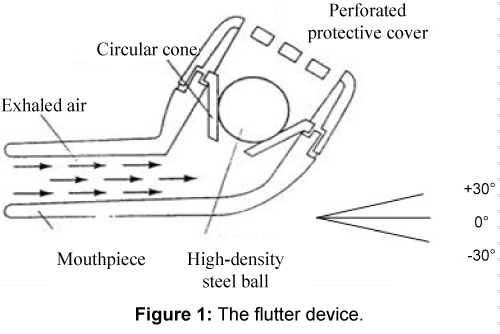

14 In addition, some patients do not like the feeling experienced when expiring through the Flutter and find the oscillating wave uncomfortable. Patients with low expiratory flows may find it difficult to generate oscillatory PEP with the Flutter. 11– 13 One study showed, a greater subject preference for the Flutter compared with active-cycle-of-breathing technique with or without gravity-assisted drainage. 10 However, when compared with combinations of gravity-assisted drainage and active-cycle-of-breathing technique, it has demonstrated no advantage in terms of sputum expectoration, oxygen saturation, spirometry measures, health-related quality of life, or breathlessness in patients with bronchiectasis. 4 The Flutter has been shown to increase sputum expectoration and to diminish peripheral airway resistance in addition to cough in subjects with bronchiectasis. Tilting the device adjusts the frequency to achieve the greatest amount of airway vibration (the individual's pulmonary resonance frequency). 4 PEP develops in the range of 10–25 cm H 2O at an oscillatory frequency of approximately 15 Hz. As the subject exhales through the Flutter, the steel ball is intermittently displaced, causing oscillations of air flow and PEP, which are transmitted down the tracheobronchial tree. The Flutter ($68) is a pipe-like device with a hardened plastic mouthpiece at one end, a protective perforated cover at the other end, and a high-density stainless steel ball resting in a plastic circular cone on the inside ( Fig. 9 The frequencies for the Lung Flute are also similar to those for the Flutter however, these 2 devices have never been compared. 4, 7 In addition, studies using the Flutter found that oscillatory waves with varying frequencies are transmitted through the airways, resulting in shearing forces that reduce viscoelasticity of bronchial secretions 8 and easier transportation. The pressure generated by PEP during expiration stabilizes airways, assists mucus movement, and prevents airway closure, thereby improving ventilation. 6 The Flutter (Aptalis Pharma, Bridgewater, New Jersey) and the Lung Flute (Medical Acoustics, Buffalo, New York) are 2 commercially available intrathoracic oscillatory positive expiratory pressure (PEP) devices designed to augment sputum expectoration.

Several airway clearance devices are commercially available to aid in sputum expectoration and optimizing outcomes, but to date, no single device has demonstrated clear superiority. 4, 5 Any effective secretion clearance regime needs to be able to be performed independently, be integrated into normal daily activities, and be cost-effective.
#Copd flutter device manual
3 Active-cycle-of-breathing technique, gravity-assisted drainage, and manual techniques are often difficult for elderly patients and those with severe disease due to comorbidities and reduced respiratory muscle and cough strength. 2 These techniques are used in combination with forced expiration technique to move the mobilized secretions to proximal airways to be cleared, which then may require subsequent cough.

2 Respiratory therapists and physiotherapists use a spectrum of airway clearance maneuvers such as active-cycle-of-breathing technique with or without gravity-assisted drainage and manual techniques as well as positive pressure devices with or without oscillations. 1Īirway clearance techniques are integral to the management of bronchiectasis, clearing conducting airways, improving pulmonary ventilation, and reducing cough and breathlessness. Impaired clearance of this mucus predisposes to mucus retention and recurrent respiratory infections. The mucus becomes colonized by bacteria and then hyperviscous and purulent. 1 In the affected areas, there is excess production of mucus due to glandular hyperplasia. Bronchiectasis is associated with damaged ciliated epithelium and compromised mucociliary clearance. Bronchiectasis is a lung disease characterized by repeated cycles of airway infection and inflammation that ultimately result in airway and lung parenchyma destruction.


 0 kommentar(er)
0 kommentar(er)
